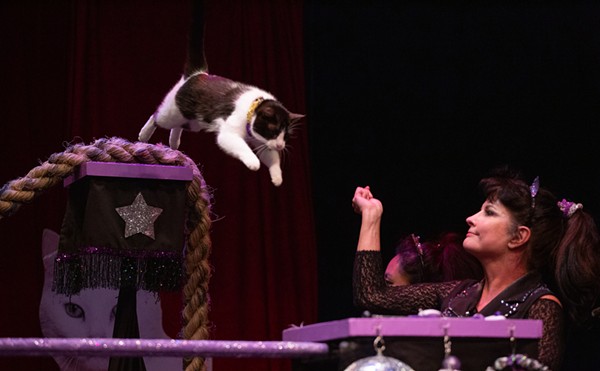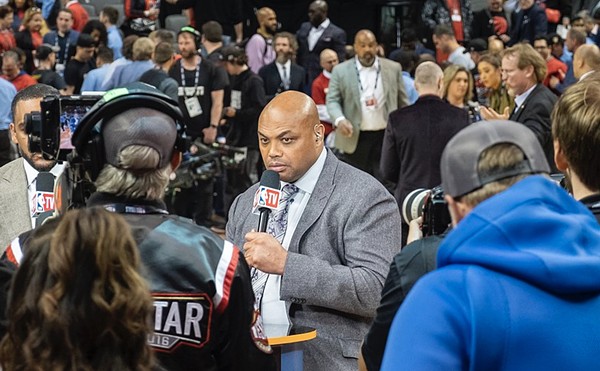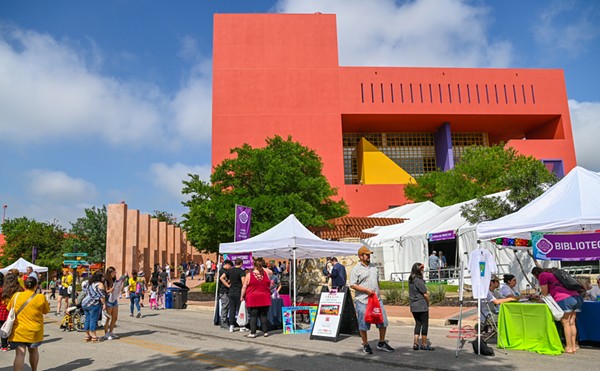Our Nation’s Birth, Remixed: A Bit of Critical Thought on the Cultural Phenomenon Hamilton: An American Musical
By Nathan Stith on Tue, May 7, 2019 at 11:11 am
First Avengers: Endgame broke our hearts, then Game of Thrones shocked us to our core, and now San Antonians get to be “in the room where it happens!” The national tour of the Broadway mega-hit and cultural phenomenon Hamilton: An American Musical finally parks itself at the Majestic Theatre for a three-week run in May. At long last, the lucky few who have secured (or dueled for) tickets will get to see what all the fuss is about.
Well, “fuss” might be a bit of an understatement. Hamilton is the most successful musical to come out of New York in years — perhaps ever. It won the 2016 Pulitzer Prize for drama and was nominated for a record 16 Tony Awards, winning 11. The musical and its creator, Lin-Manuel Miranda, have been featured in Time, Rolling Stone, CBS Sunday Morning and 60 Minutes, and were even the subject of a PBS documentary. The cast album nabbed a Grammy Award, shot to No. 3 on the Billboard chart, and became the first musical cast recording to ever reach No. 1 on the Billboard Top Rap Albums Chart.
At first (and even second and third) glance, the subject matter seems unpromising: a biography of America’s first secretary of the treasury, Alexander Hamilton. But what makes this musical unique is not simply the subject matter, but its innovative style. Miranda has chosen to tell the story of America’s past using the music of America today, employing (most conspicuously) hip-hop, R&B, soul and contemporary pop. In addition, the creative team of Miranda and director Thomas Kail have cast actors of color as the key figures in Hamilton’s life, from his wife Eliza and her sisters Angelica and Peggy to the hallowed troika of George Washington, Thomas Jefferson and Aaron Burr. This color-conscious casting allows the musical to become what Miranda calls “a story about America then, told by America now.” These bold choices in casting and composition rocked the musical theater world and created a cultural phenomenon that reaches far beyond Broadway and musical theater lovers.
Moreover, Hamilton’s success has spilled beyond the stage itself. Hamilton has also spawned a book, aptly titled Hamilton: The Revolution, in which Miranda and co-author Jeremy McCarter offer behind-the-scenes details about the process of writing the musical and bringing it to the stage. This affectionately nicknamed “hamiltome” ranked No. 1 among the New York Times best-selling non-fiction books for seven months in a row. There is also Hamilton Mixtape, a best-selling album of covers from the show sung by a wide range of contemporary pop and hip-hop artists from Kelly Clarkson to Chance the Rapper. Obviously fans of musical theater and hip-hop are drawn to the musical, as are history buffs young and old, but the fan base includes people of all class and racial backgrounds, and across the political spectrum. The Obamas were early supporters — and at a 2016 White House event, the former President noted that Hamilton, “is the only thing Dick Cheney and I agree on.”
But why does this particular story speak to such a broad audience? In a nutshell, it couldn’t be more American. Alexander Hamilton, an orphaned immigrant from the West Indies, pulls himself up by his bootstraps and uses his intellect and determination to become George Washington’s treasurer and right-hand man. As a sort of bonus, the musical includes a heart-wrenching love triangle, as well as our nation’s first Beltway sex scandal, leading to Hamilton’s political downfall. Finally the musical’s climax — a spoiler alert for those of you who slept through high school — is a powerful staging of Hamilton’s untimely death in a duel with his nemesis, fellow founding father Aaron Burr. It is a story filled with historical significance and contemporary relevance, made all the more significant and relevant by its multiracial cast.
The response from critics and the bloggerati has been universally positive. Upon Hamilton’s Broadway premiere, Ben Brantley of the New York Times trumpeted, “Yes, it really is that good.” David Cote of Time Out New York declared it “the greatest American musical in decades” while the New York Daily News’ Joe Dziemianowicz argued that with the opening of Hamilton, “Broadway is the coolest place on the planet. And the smartest. And most exhilarating.”
But more recent critical reactions, particularly from the academy, have complicated this appraisal, including reevaluations of some of the aspects initially praised as innovative. A growing number of scholars have written that, despite being fans of the musical, they are sometimes troubled by the production’s color-conscious casting choices, as well as elements of the musical’s plot and character development. While the impact and import of this musical is undeniable, these issues are worth examining for anyone who also considers themselves to be a fan of Hamilton: An American Musical.
With few exceptions, actors of color have been notoriously absent from the Broadway stage throughout its history. Miranda’s choice to retell the founding of our nation using a multiracial cast is significant because it offers the opportunity for a group of artists to tell the creation story of a nation they are a part of, but one in which they have been, thus far, excluded from narrating. But Hamilton’s radical solution might generate problems of its own. As University of Richmond Latinx studies professor Patricia Herrera argues, “Hamilton creates a mirage of equity and inclusivity with its reverse casting,” an illusion of racial parity clearly at odds with the play’s historical circumstances and the future arc of America.
In addition, some scholars argue the multiracial casting ignores the social realities of people of color in 18th-century America. Rutgers University history professor Lyra D. Montiero points out the irony: “It is problematic to have black and brown actors stand in for the great white men of the early United States in a play that does not acknowledge that the ancestors of these same actors were excluded from the freedoms for which the founders fought.” Conspicuously, the issue of slavery is mostly elided in Miranda’s musical (the subject is briefly acknowledged during one of the cabinet rap battles between Hamilton and Jefferson). Jefferson’s slave mistress Sally Hemmings is the only slave mentioned by name, and she does not speak. Some critics warn that this color-conscious casting thus offers a sense of our history that is both incomplete and misleading.
Miranda based his musical on Ron Chernow’s successful 2004 biography Alexander Hamilton and he brought Chernow onboard as a historical consultant during the development period. While much of the musical is historically accurate, like any historical drama, Miranda does take some liberties. Hamilton is painted as a man of the people, but as Princeton University historian Sean Wilentz points out, he was “more a man for the 1% than the 99%.” It is also likely that Hamilton and Burr’s relationship was not quite as acrimonious as depicted in the musical. These changes do make the main character more relatable and the story more dramatic. However, as feminist scholar Stacy Wolf notes, the depiction of the female characters in Hamilton might give one pause. Wolf suggests that the three central female characters, Eliza (Hamilton’s wife), Angelica (Eliza’s sister) and Maria Reynolds (Hamilton’s mistress) are, alas, little more than the stereotypical “wife,” “muse” and “whore.” Eliza is loyal to her husband but then becomes “the sympathetic long-suffering wife” when she learns of Hamilton’s affair. Angelica, whom Miranda calls “the smartest character in the musical,” is indeed sharp as a tack, but ultimately does little more than inspire Hamilton and encourage him when needed. Finally, Maria Reynolds’ sole role in the musical is to seduce Hamilton. Despite the fact that Eliza and Angelica are intelligent and progressive-minded (Angelica quips she’ll ask Jefferson to put women in the “sequel” to the Declaration of Independence) the female characters are comparatively underdeveloped. While one may forgive Miranda for his use of literary license when it comes to the character of Hamilton, it does seem that with respect to gender, his choices take as many steps backward as forward.
Ironically, it’s the enormous canvas of Hamilton, its crazy-ambitious sweep, which invites such scrutiny: clearly this is the most important musical of the 21st century. But because it’s such a cultural touchstone, it’s all the more imperative to think critically about the artistic choices being made and the impact of those choices, especially for Hamilton’s probable influence on the trajectory of American theater. Whatever its historical (de)merits, any musical is ultimately its own semiotic system, tuned for disseminating cultural values attached to a fictionalized narrative: in this case, the birth of our nation. Here, it’s retold by artists who represent us — and that includes you, me, all of us — as a nation of immigrants, in a way that speaks to people across generations, ideological spectrums and racial differences. In a time when it seems almost impossible for anyone or anything to bring Americans together, Hamilton seems to have done just that.
Hamilton: An American Musical
$140-$923, May 7-26, 7:30pm Tue-Thu, 8pm Fri, 2pm & 8pm Sat-Sun, the Majestic Theatre, 224 E. Houston St., (210) 226-3333, majesticempire.com.
Get our top picks for the best events in San Antonio every Thursday morning. Sign up for our Events Newsletter.
Well, “fuss” might be a bit of an understatement. Hamilton is the most successful musical to come out of New York in years — perhaps ever. It won the 2016 Pulitzer Prize for drama and was nominated for a record 16 Tony Awards, winning 11. The musical and its creator, Lin-Manuel Miranda, have been featured in Time, Rolling Stone, CBS Sunday Morning and 60 Minutes, and were even the subject of a PBS documentary. The cast album nabbed a Grammy Award, shot to No. 3 on the Billboard chart, and became the first musical cast recording to ever reach No. 1 on the Billboard Top Rap Albums Chart.
At first (and even second and third) glance, the subject matter seems unpromising: a biography of America’s first secretary of the treasury, Alexander Hamilton. But what makes this musical unique is not simply the subject matter, but its innovative style. Miranda has chosen to tell the story of America’s past using the music of America today, employing (most conspicuously) hip-hop, R&B, soul and contemporary pop. In addition, the creative team of Miranda and director Thomas Kail have cast actors of color as the key figures in Hamilton’s life, from his wife Eliza and her sisters Angelica and Peggy to the hallowed troika of George Washington, Thomas Jefferson and Aaron Burr. This color-conscious casting allows the musical to become what Miranda calls “a story about America then, told by America now.” These bold choices in casting and composition rocked the musical theater world and created a cultural phenomenon that reaches far beyond Broadway and musical theater lovers.
Moreover, Hamilton’s success has spilled beyond the stage itself. Hamilton has also spawned a book, aptly titled Hamilton: The Revolution, in which Miranda and co-author Jeremy McCarter offer behind-the-scenes details about the process of writing the musical and bringing it to the stage. This affectionately nicknamed “hamiltome” ranked No. 1 among the New York Times best-selling non-fiction books for seven months in a row. There is also Hamilton Mixtape, a best-selling album of covers from the show sung by a wide range of contemporary pop and hip-hop artists from Kelly Clarkson to Chance the Rapper. Obviously fans of musical theater and hip-hop are drawn to the musical, as are history buffs young and old, but the fan base includes people of all class and racial backgrounds, and across the political spectrum. The Obamas were early supporters — and at a 2016 White House event, the former President noted that Hamilton, “is the only thing Dick Cheney and I agree on.”
But why does this particular story speak to such a broad audience? In a nutshell, it couldn’t be more American. Alexander Hamilton, an orphaned immigrant from the West Indies, pulls himself up by his bootstraps and uses his intellect and determination to become George Washington’s treasurer and right-hand man. As a sort of bonus, the musical includes a heart-wrenching love triangle, as well as our nation’s first Beltway sex scandal, leading to Hamilton’s political downfall. Finally the musical’s climax — a spoiler alert for those of you who slept through high school — is a powerful staging of Hamilton’s untimely death in a duel with his nemesis, fellow founding father Aaron Burr. It is a story filled with historical significance and contemporary relevance, made all the more significant and relevant by its multiracial cast.
The response from critics and the bloggerati has been universally positive. Upon Hamilton’s Broadway premiere, Ben Brantley of the New York Times trumpeted, “Yes, it really is that good.” David Cote of Time Out New York declared it “the greatest American musical in decades” while the New York Daily News’ Joe Dziemianowicz argued that with the opening of Hamilton, “Broadway is the coolest place on the planet. And the smartest. And most exhilarating.”
But more recent critical reactions, particularly from the academy, have complicated this appraisal, including reevaluations of some of the aspects initially praised as innovative. A growing number of scholars have written that, despite being fans of the musical, they are sometimes troubled by the production’s color-conscious casting choices, as well as elements of the musical’s plot and character development. While the impact and import of this musical is undeniable, these issues are worth examining for anyone who also considers themselves to be a fan of Hamilton: An American Musical.
With few exceptions, actors of color have been notoriously absent from the Broadway stage throughout its history. Miranda’s choice to retell the founding of our nation using a multiracial cast is significant because it offers the opportunity for a group of artists to tell the creation story of a nation they are a part of, but one in which they have been, thus far, excluded from narrating. But Hamilton’s radical solution might generate problems of its own. As University of Richmond Latinx studies professor Patricia Herrera argues, “Hamilton creates a mirage of equity and inclusivity with its reverse casting,” an illusion of racial parity clearly at odds with the play’s historical circumstances and the future arc of America.
In addition, some scholars argue the multiracial casting ignores the social realities of people of color in 18th-century America. Rutgers University history professor Lyra D. Montiero points out the irony: “It is problematic to have black and brown actors stand in for the great white men of the early United States in a play that does not acknowledge that the ancestors of these same actors were excluded from the freedoms for which the founders fought.” Conspicuously, the issue of slavery is mostly elided in Miranda’s musical (the subject is briefly acknowledged during one of the cabinet rap battles between Hamilton and Jefferson). Jefferson’s slave mistress Sally Hemmings is the only slave mentioned by name, and she does not speak. Some critics warn that this color-conscious casting thus offers a sense of our history that is both incomplete and misleading.
Miranda based his musical on Ron Chernow’s successful 2004 biography Alexander Hamilton and he brought Chernow onboard as a historical consultant during the development period. While much of the musical is historically accurate, like any historical drama, Miranda does take some liberties. Hamilton is painted as a man of the people, but as Princeton University historian Sean Wilentz points out, he was “more a man for the 1% than the 99%.” It is also likely that Hamilton and Burr’s relationship was not quite as acrimonious as depicted in the musical. These changes do make the main character more relatable and the story more dramatic. However, as feminist scholar Stacy Wolf notes, the depiction of the female characters in Hamilton might give one pause. Wolf suggests that the three central female characters, Eliza (Hamilton’s wife), Angelica (Eliza’s sister) and Maria Reynolds (Hamilton’s mistress) are, alas, little more than the stereotypical “wife,” “muse” and “whore.” Eliza is loyal to her husband but then becomes “the sympathetic long-suffering wife” when she learns of Hamilton’s affair. Angelica, whom Miranda calls “the smartest character in the musical,” is indeed sharp as a tack, but ultimately does little more than inspire Hamilton and encourage him when needed. Finally, Maria Reynolds’ sole role in the musical is to seduce Hamilton. Despite the fact that Eliza and Angelica are intelligent and progressive-minded (Angelica quips she’ll ask Jefferson to put women in the “sequel” to the Declaration of Independence) the female characters are comparatively underdeveloped. While one may forgive Miranda for his use of literary license when it comes to the character of Hamilton, it does seem that with respect to gender, his choices take as many steps backward as forward.
Ironically, it’s the enormous canvas of Hamilton, its crazy-ambitious sweep, which invites such scrutiny: clearly this is the most important musical of the 21st century. But because it’s such a cultural touchstone, it’s all the more imperative to think critically about the artistic choices being made and the impact of those choices, especially for Hamilton’s probable influence on the trajectory of American theater. Whatever its historical (de)merits, any musical is ultimately its own semiotic system, tuned for disseminating cultural values attached to a fictionalized narrative: in this case, the birth of our nation. Here, it’s retold by artists who represent us — and that includes you, me, all of us — as a nation of immigrants, in a way that speaks to people across generations, ideological spectrums and racial differences. In a time when it seems almost impossible for anyone or anything to bring Americans together, Hamilton seems to have done just that.
Hamilton: An American Musical
$140-$923, May 7-26, 7:30pm Tue-Thu, 8pm Fri, 2pm & 8pm Sat-Sun, the Majestic Theatre, 224 E. Houston St., (210) 226-3333, majesticempire.com.
Get our top picks for the best events in San Antonio every Thursday morning. Sign up for our Events Newsletter.

KEEP SA CURRENT!
Since 1986, the SA Current has served as the free, independent voice of San Antonio, and we want to keep it that way.
Becoming an SA Current Supporter for as little as $5 a month allows us to continue offering readers access to our coverage of local news, food, nightlife, events, and culture with no paywalls.
Scroll to read more Arts Stories & Interviews articles
Newsletters
Join SA Current Newsletters
Subscribe now to get the latest news delivered right to your inbox.
















